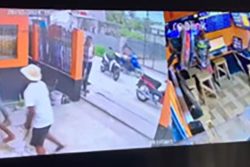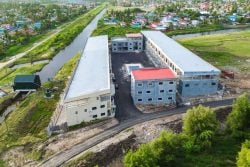Dear Editor,
In July1958, Dattatreya Balkrushna Kalelkar (1885-1981), an Indian nationalist, visited British Guiana. Kalelkar was described as “…a freedom fighter, social and political worker, journalist, publicist, and educationist, shuttlecocking between the Ashram and jails…” Originally from the Indian state of Maharashtra, where the famous paintings and rock-cut sculptures of Ajanta and Ellora are found, Kalelkar was considered a notable political activist during India’s independence movement. A loyal follower and protégé of Mahatma Gandhi, he was appointed a member of the Rajya Sabha, the upper house of India’s bicameral parliament, from 1952 to 1964. He was also president of India’s Commis-sion for Backward Classes Commission in 1953, the same year British Guiana held its first election under universal adult suffrage.
Kalelkar was credited with having written some eighty books, published in Marathi, Gujarati, Hindi, and English, which have been widely read in India. His commentary on the Bhagavad Gita and translations of Rabindranath Tagore’s classical works into Marathi and Gujarati were some of his most impressive accomplishments. He received India’s second-highest civilian award, the Padma Vibhushan, in 1964. Hari hosted Kalelkar during his visit to Guyana. He must have been immensely impressed by his guest. It is possible, too, that Kalelkar may have inspired Hari, whom he referred to as “Hariprashad ji,” culturally and politically. In his travel log of the many places he visited in British Guiana, Kalelkar described his initial visit to Georgetown with these words:
“… The house we live in is opposite Georgetown Railway Station. Due to the absence of crowds going from the station to the port, one could see the beauty of the wide-open road. All the houses here, being built on pillars and having wooden walls, create a beautiful map in the city structure. All houses white! That is why instead of calling this city Georgetown, I must have called it Sudha Nagari or Dhavalpuri. The roads here are very straight and wide and due to being divided into two parts by a canal flowing in the middle…” “Sudha,” a Sanskrit word, has several meanings, but it is usually a name given to a girl child, meaning “nectar,” while “Nagari” translated to mean “beautiful city.” “Dhaval” is also a name given to a child, which is translated to mean “white.” “Puri” means city, so the word “Dhavalpuri” could certainly be translated to mean “white city.” Presumably, Kalelkar was impressed with the colour of the many “white houses” he discovered in Georgetown.
Remarkably, when Hari designed Prashad Nagar (with the help of town planner Audrey Barker), he attached Indian names to all the streets, including names of his family, places in India, and of Indians in Guyana. He named one of the streets “Kaka Street” out of respect and admiration for Kalelkar. However, one will never be able to locate the name “Kaka Street,” although it was an original moniker that Hari assigned to one of the streets. This street, perhaps more than Hari’s choice of street names, preserved an enduring cultural history and a legacy that eternally linked Hari with ancestral India. He had taken his family to live in India in 1952 but returned in 1953. Hari’s deliberate naming of “Kaka” as a street name was a natural outgrowth rooted in his cultural connection with the land of his Indian ancestors. More importantly, it is a name that gives us a glimpse into Hari’s philosophical thinking and the unshakably profound, enduring, and unbreakable cultural embrace he shared with India. The name, however, was not without its controversy, as readers familiar with Guyanese colloquialism, would have surmised by now.
Hari was aware that Kalelkar was revered as “Kakasaheb” or “Kaka” as a sign of respect for his meaningful contributions to India’s independence struggle. Contrary to what some individuals may think, Kaka (which is another word for “cha-cha”) is also a very dignified term commonly used among Indians in Guyana and the wider Caribbean. Its usage as “Chacha” or “Khakhaa” with reference to a father’s younger brother can be traced to its original usage in ancestral India. Here in Guyana, it is sometimes used in reference to both a father’s younger and older brother. For most Indians, all of one’s father’s brothers are called “Chacha.” It is important to note, too, that in Indian culture, such words are “relationship words” that connote familial respect among family members. As such, their usage has nothing to do with age.
The creolization of Guyanese culture, particularly in the use of the word “kaka,” has contributed to the elimination of a key historical reference for which Hari originally intended for his housing scheme. The fact that a bureaucratic adoption, using “Omai” instead as a replacement for “Kaka,” was arbitrarily selected for Hari’s originally intended designation for his urban village can be considered an attack on the Indian archive, and a desecration of Hari’s memory and his enduring legacy. Regardless of the thinking process that was associated with this name change, which remains unexplainable and perplexing to Hari’s son-in-law, the late Prem Persaud, no explanation was forthcoming from any government authorities on the reason behind the name change.
Prem Persaud surmised that there were two possible explanations for this erasure. For one, the name “Kaka” may not have been recorded in the transport survey. If one were to submit an application for the purchase of a piece of land in the “short street behind Sachibazaar,” the name “Kaka” would not appear on the survey. The use of the name was Hari’s prerogative. Two, Prem Persaud surmised that it’s possible that, over time, some people who lived on that street may have substituted the name “Omai” because several individuals who resided in the street were workers associated with the Canadian gold mining company, Omai Gold Mines Ltd. (OGML), which began operations in the Cuyuni-Mazaruni region in the early 1990s.
Unfortunately, what can most probably be attributed to a combination of creeping globalization, cultural neglect, and historical amnesia has led to the erasure of this historic street name in Prashad Nagar. Today, Kaka Street bears the name “Omai Street.” At the launching of a book on Hari Prashad on June 23 on the Indo-Caribbean Cultural Centre show, Evan Persaud noted that the combined Bel Air/Prashad Nagar PPP group is perhaps the most influential and most organized PPP group in the country today. The PPP group boasts membership of two sitting Ministers from the area (Ministers Vindhya Persaud and Collin Croal), among a slew of other prominent Guyanese. Perhaps Evan and his group can mount a lobbying effort to correct this historical anomaly.
Sincerely,
Baytoram Ramharack




